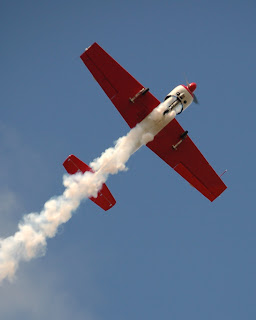
Last March I was fortunate enough to be one of ten civilian pilots chosen to spend a week testing the NASTAR Center's ATFS-400 Phoenix. The ATFS-400 is a multi-million dollar full motion flight simulator based on a 25 foot planetary arm capable of high onset, high offset, and sustained Gs. The ATFS-400 has interchangeable pods, each set up as an actual tactical aircraft cockpit such as a F-15, F-16, or a F-18. The idea of the ATFS-400 is to provide in training, real physiological stresses associated with actual combat flight that is, "as close as it comes to flying an actual aircraft without leaving the ground".
I was truly blown away with the NASTAR Center and the ATSF-400 flight simulator. The purpose of our test was, exploring the effects of off center viewing and adaption to a centrifuge based flight simulator. Perhaps the video below can give a better account of what the ATSF-400 can do as well as the purpose of our test.
Although I can't go into detail of the testing, I can say, I did not pass out and I did not get sick! But I can talk about our free flight we were given at the end of our testing. See, during this whole time the ATSF-400 was set up as an F-15 and I was going to get to put an F-15 and myself through the paces during my free flight! The scenario that was set up for us was a carrier launch, followed by some free flight, and finish with a carrier landing. Remember, it's a flight simulator, anything is possible.
I have to admit, the aircraft carrier launch was a blast and felt like I would imagine it feeling! After the launch I climbed for altitude and did a series of steep turns in both directions. Then the aerobatic pilot in me gets involved, it was time to roll an F-15! I started with a couple two point rolls which I over rotated both times. I then rolled inverted and maintained for a bit. I did some full rolls. Then I did a reverse half Cuban followed by a regular Cuban. Then it was time to do the carrier landing. After getting some instruction, I got all lined up and did a perfect touch and go followed by a victory roll to finish my aerobatic flight in an F-15!
This was an amazing experience, and I have to say, it feels like you are in a real aircraft. The one thing I don't remember is being thrown to the opposite direction from the roll as you would in a quick roll. Pitch was spot on though. It does produce the high onset and high offset of G as you would by pulling hard and then unloading quickly. In the steep turns and in the Cubans, sustained Gs were there as long as I pulled. Having flown only smaller aircraft and nothing that was hydraulically assisted or electronically controlled, stick forces seemed rather numb to me, but this might be normal in the actual aircraft. In all the aircraft I fly, the linkage from the stick to the control surface is somewhat direct. So, as the forces increase on the control surface, those forces can be felt through the stick. Without this feel, I had to rely on visual cues and the onset and offset of G to give me feedback. Again, this might be a normal thing in modern fighter aircraft, and I would expect it would be. I did experiment a bit looking around off center as I typically would flying aerobatics and I didn't feel any tumbling sensations that has plagued centrifuge based flight simulators in the past.
I truly believe that the ATFS-400 Phoenix is the future of Tactical Flight Training Simulators by providing real world combat scenarios and the real physiological stresses that comes with such missions in a safe environment. I know that the ATFS-400 could save governments millions of dollars by shifting some of the training from actual aircraft to simulators while maintaining extremely effective training.


















